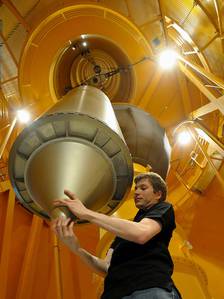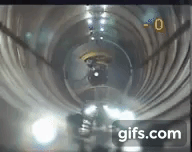 |
| The tower in all its glory (from the ZARM website). |
The main goal of this facility is to provide microgravity environments for physics experiments, on a scale more accessible than orbital space launch or parabolic aircraft. Besides answering the kinds of questions that keep us up at night, like how cats behave in zero gravity, microgravity is a useful method to control the effective gravitational field in an experiment. As Albert Einstein reminds us, true freefall is indistinguishable from inertial rest, and remaining static in a gravitational field is indistinguishable from uniform acceleration. If you want your experiment to take place in a truly inertial reference frame, dropping it down a tower is a simple way to achieve this.
 |
| The entire experiment is built into a capsule like this, and then launched. |
Initially, it was simply a drop facility: an experiment built into a modular capsule could be raised by an elevator and dropped from the top of the tower, falling 120 meters and experiencing four seconds of freefall. In 2004 the facility was modified to include a catapult launch with an initial speed of 168 km/h, giving it twice the freefall time but making the facility at least eight times as cool.
 |
| A gif of a lanch and landing, pillaged from this youtube video. |
Based on a few videos of the facility, it appears that immediately after launch, a crash pad full of protective foam slides into place, protecting the experiment as it lands. Some of the videos are quite well done, check them out if you're interested.
Launch and landing.
I first became aware of this experiment when I read a paper (or possibly a news article) about launching a Bose-Einstein condensate in the catapult. In quantum mechanics class, we learn that a system whose wavefunction that is initially a Dirac delta will expand isotropically through time-evolution, becoming more spread out. Bose-Einstein condensates, functionally made of cold atoms in an electromagnetic trap, serve as a good experimental system for wavefunction dynamics because they are much larger than an individual particle while still behaving like one. However, none of those quantum mechanics homework problems included an anisotropic acceleration vector like we have on Earth's surface, and breaking the symmetry like that causes the condensate to expand differently than it would in true freefall. To measure this predicted isotropic expansion, the research group launched their experimental from a catapult. Because these Bose-Einstein condensates are so sensitive to acceleration, the group was proposing they could be used for accelerometers in spacecraft navigation systems. We will see if that actually happens.
 |
| The Bose-Einstein Projectile, from the Humboldt University group. |
Not every experiment is as exotic, sometimes it's used to characterize apparati that will eventually be launched on satellites. Some experiments are testing the expansion of explosions in microgravity rather than atomic condensates, both for science's sake and also to gauge safety protocols aboard spacecraft. There are also some biological experiments, for example studying how fish orient themselves and turn in microgravity (I guess they couldn't get the approval to use cats), and others to test how plants perceive gravity (I feel like "how to plants know to grow up" can become a pretty complicated question. The projects are listed on the ZARM website, some in English and some in German.
My experiments typically take place in a little pocket of fluid on a piece of glass on top of a microscope on an optical table in a stationary lab. Compared to launching an experiment from a catapult, that seems rather mundane.
No comments:
Post a Comment